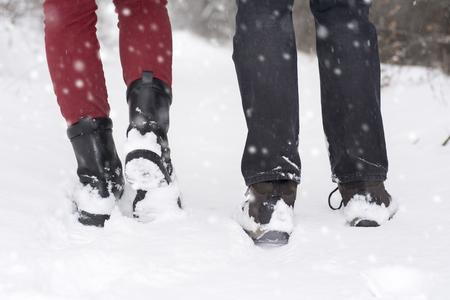The cold weather has come and it looks like it’s here to stay! We’ve talked about “Keeping Your Feet Warm” and “Winter Foot Care for Diabetics” in previous posts, but another important aspect of winter foot care includes choosing the right footwear during these cold months. The following are some questions to consider when choosing your winter boots to keep your feet injury and pain-free:

What is the condition of any winter boots that you already own?
- Do they still fit you, and are they comfortable when you put them on? Do they support your arch and heels, or do the insoles feel flat?
- Also, check the outer sole. One of the most important parts of winter boots are their non-skid properties, so if tread on the outer sole has worn down (and if the other parts of the shoes are worn out), it’s important to get a new pair.
What is the weather like where you live?
- Do you get a lot of snow (and need non-slip tread) or are you more likely to encounter ice (in which case you may need ice grip attachments)? Maybe everything becomes slushy, so your priority is waterproofing.
What activities will you be performing?
- If you won’t be performing any winter-related sports activities or trekking out into the wilderness, it’s likely that regular winter boots – comfortable, warm, with good tread on the outer sole – will do the job.
- However, if you will be participating in activities like winter hiking, ice fishing, or even ice climbing, you’d better have the appropriate shoes that are specifically designed to keep you safe during those activities. They will have features like built-in liners, laces that you can tighten (as opposed to slip on boots), and waterproofing to keep your feet warm and dry. During most of these activities, you’ll likely be in very cold temperatures, so even the slightest bit of wetness in the shoes can lead to frostbite!
What kind of socks will you be wearing?
- Especially when trying on new activity-specific shoes, make sure to wear the socks (or ones of the same thickness) that you plan to wear with them to ensure a good fit. If you change the socks, it can affect the fit, either leaving too much room in the shoes or being too tight. This could affect performance, restrict blood flow to your toes, or cause your feet to slide around inside, reducing agility.
- For everyday winter boots, you should still wear socks with your shoes, even if they are fur-lined. While they may be warm, the warmth can actually cause your feet to sweat and increase foot odor. Beyond that, you can bring germs like bacteria and fungus into your shoes, which can live in your warm boots. Wear clean socks each day to prevent infection.
Do you have concerns about how your winter boots fit? You may need custom orthotic inserts, especially if you have previous foot or ankle issues. Consult with our board-certified podiatrist, Dr. Brad Toll at Crofton Podiatry. Make an appointment at our Crofton, MD office, which also serves the surrounding Gambrills, Odenton, and Bowie areas. Call (410) 721-4505 today to receive a thorough assessment by our dedicated podiatric team.
